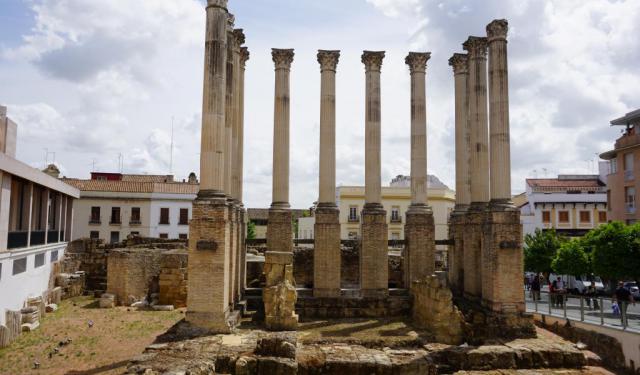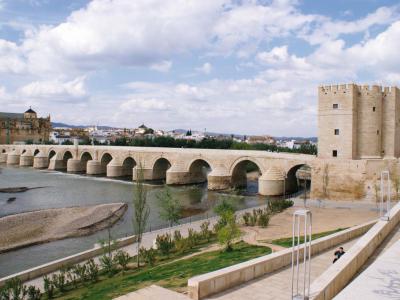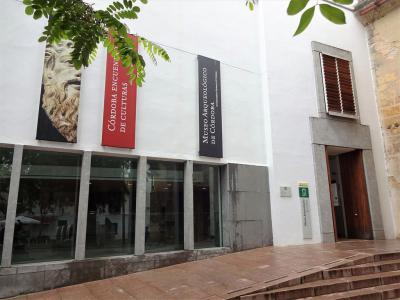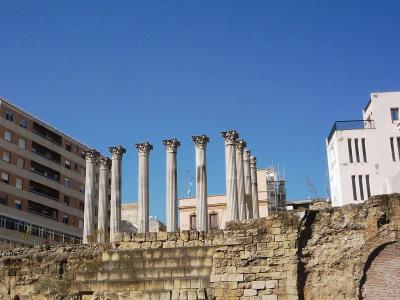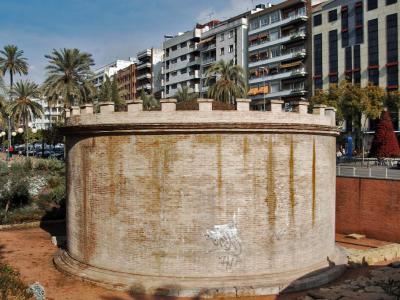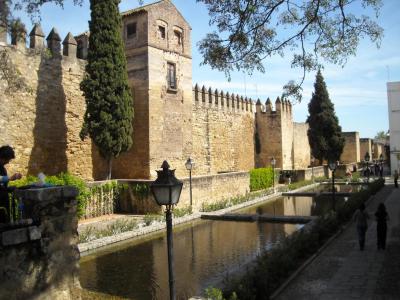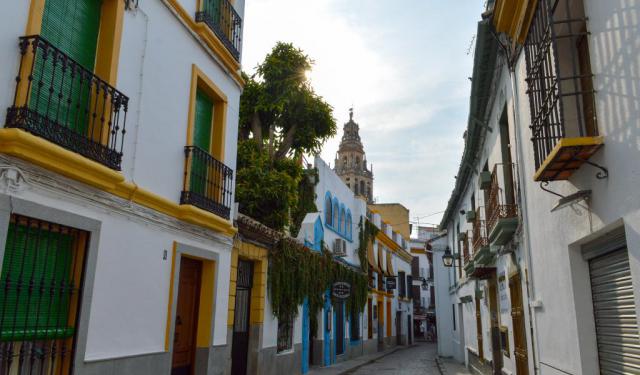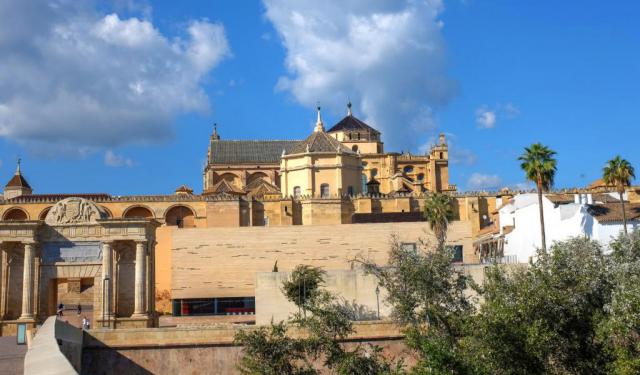Ancient Roman Sites Walking Tour (Self Guided), Cordoba
Under all in Cordoba lies a once redoubtable Roman strongpoint. After Scipio's defeat of the Carthaginians in Llipa, the victorious Romans set up camp by the Guadalquivir River.
Under Augustus, the city gained the status of Colonia Patricia. A perimeter wall was built touching the Guadalquivir River. There were two forums, colonial and provincial. A large amphitheater has been uncovered. There are enormous temples, including one on Claudio Marcelo Street (Calle Claudio Marcelo).
The Roman Temple (Templo Romano) on Claudio Marcelo Street was completed in the reign of Domitian (81-96 AD) and discovered in the 1950s. It was dedicated to the Emperor, and with the Circus Maximus, it was part of the Provincial Forum. The ruin has six free-standing Corinthian columns and an altar. It can be found on Capitulares Street (Calle Capitulares).
The Puente Romano (Roman Bridge) is still in use. It was built in the first century BC. It crosses the Guadalquivir River. It was built during the reign of Augustus and reconstructed by the Moorish administration in the 8th century AD. The Cordoba Archeological Museum houses remain of the Roman theatre and items from Roman Temple.
Two milestones from the ancient Augusta Road (Via Augusta) are now part of the entrance of the great Mosque-Cathedral of Cordoba. Traces of the church of Bishop Ossius, Saint Victor of 325 AD, are beneath the mosque. In the Victoria Gardens (Jardines de la Victoria) is the Roman mausoleum of Cordoba. It is a cylinder-shaped crenelated stone monument of the 1st century AD.
The site of the Palace of Maximianus Herculius was unearthed in the northwest corner of the city. Maximianus was Emperor from 286 to 305 AD. It was a turbulent time. The Visigoths converted it into the basilica of Martyr San Aciscio. The layout of the site is by the parking lot of today's railway station. Signs are posted.
Archeologists have concluded Roman Cordoba had three aqueducts, a circus, an amphitheater, a theatre, baths, and two forums. Of course, it had houses, too. Archeologists are still looking.
Under Augustus, the city gained the status of Colonia Patricia. A perimeter wall was built touching the Guadalquivir River. There were two forums, colonial and provincial. A large amphitheater has been uncovered. There are enormous temples, including one on Claudio Marcelo Street (Calle Claudio Marcelo).
The Roman Temple (Templo Romano) on Claudio Marcelo Street was completed in the reign of Domitian (81-96 AD) and discovered in the 1950s. It was dedicated to the Emperor, and with the Circus Maximus, it was part of the Provincial Forum. The ruin has six free-standing Corinthian columns and an altar. It can be found on Capitulares Street (Calle Capitulares).
The Puente Romano (Roman Bridge) is still in use. It was built in the first century BC. It crosses the Guadalquivir River. It was built during the reign of Augustus and reconstructed by the Moorish administration in the 8th century AD. The Cordoba Archeological Museum houses remain of the Roman theatre and items from Roman Temple.
Two milestones from the ancient Augusta Road (Via Augusta) are now part of the entrance of the great Mosque-Cathedral of Cordoba. Traces of the church of Bishop Ossius, Saint Victor of 325 AD, are beneath the mosque. In the Victoria Gardens (Jardines de la Victoria) is the Roman mausoleum of Cordoba. It is a cylinder-shaped crenelated stone monument of the 1st century AD.
The site of the Palace of Maximianus Herculius was unearthed in the northwest corner of the city. Maximianus was Emperor from 286 to 305 AD. It was a turbulent time. The Visigoths converted it into the basilica of Martyr San Aciscio. The layout of the site is by the parking lot of today's railway station. Signs are posted.
Archeologists have concluded Roman Cordoba had three aqueducts, a circus, an amphitheater, a theatre, baths, and two forums. Of course, it had houses, too. Archeologists are still looking.
How it works: Download the app "GPSmyCity: Walks in 1K+ Cities" from Apple App Store or Google Play Store to your mobile phone or tablet. The app turns your mobile device into a personal tour guide and its built-in GPS navigation functions guide you from one tour stop to next. The app works offline, so no data plan is needed when traveling abroad.
Ancient Roman Sites Walking Tour Map
Guide Name: Ancient Roman Sites Walking Tour
Guide Location: Spain » Cordoba (See other walking tours in Cordoba)
Guide Type: Self-guided Walking Tour (Sightseeing)
# of Attractions: 5
Tour Duration: 1 Hour(s)
Travel Distance: 2.5 Km or 1.6 Miles
Author: DanaOffice
Sight(s) Featured in This Guide:
Guide Location: Spain » Cordoba (See other walking tours in Cordoba)
Guide Type: Self-guided Walking Tour (Sightseeing)
# of Attractions: 5
Tour Duration: 1 Hour(s)
Travel Distance: 2.5 Km or 1.6 Miles
Author: DanaOffice
Sight(s) Featured in This Guide:
- Puente Romano de Cordoba (Roman Bridge of Cordoba)
- Archaeological Museum and Roman Theatre
- Templo Romano (Roman Temple)
- Mausoleo Romano (Roman Mausoleum)
- Murallas Romana de Cordoba (Roman Walls of Cordoba)
1) Puente Romano de Cordoba (Roman Bridge of Cordoba) (must see)
Stretching across the Guadalquivir River with quiet confidence is Cordoba’s Roman Bridge-less “majestic” and more “still standing after two millennia.” On one end, the Mosque-Cathedral anchors the view; on the other, the Calahorra Tower keeps watch. Back in the 12th century, Arab cartographer Muhammad al-Idrisi wasn’t shy with praise-he called it the best-looking, sturdiest bridge around.
Originally built in the 1st century BC, it carried the mighty Augusta way, the Roman highway that once stitched together Rome and Cádiz. In the early 700s, the bridge had a full makeover-sixteen arches, 800-plus feet long, wide enough for carts, soldiers, and the occasional goat.
Let's skip forward to the medieval times: the Calahorra Tower was added on one side, and the Gate of the Bridge on the other. A statue of Saint Raphael landed center stage in the 17th century. Over the years, repairs came and went-today, only two arches on the north end remain truly Roman. The rest? Roman-adjacent.
In 2006, a major restoration stirred the pot. Architect Juan Montilla gave the bridge a polish-pink granite paving, minimalist lighting, and a tidy-up of the starling-shaped breakwaters. Even the saints’ niches got spruced up. The north end was lifted slightly to meet the riverside promenade-practical, if not purist.
Now protected as a cultural monument since 1931, the bridge, gate, and tower joined UNESCO’s World Heritage list in 1984. Oh, and for fantasy fans: the Roman Bridge served as the Long Bridge of Volantis in Game of Thrones. Try not to imagine dragons.
Originally built in the 1st century BC, it carried the mighty Augusta way, the Roman highway that once stitched together Rome and Cádiz. In the early 700s, the bridge had a full makeover-sixteen arches, 800-plus feet long, wide enough for carts, soldiers, and the occasional goat.
Let's skip forward to the medieval times: the Calahorra Tower was added on one side, and the Gate of the Bridge on the other. A statue of Saint Raphael landed center stage in the 17th century. Over the years, repairs came and went-today, only two arches on the north end remain truly Roman. The rest? Roman-adjacent.
In 2006, a major restoration stirred the pot. Architect Juan Montilla gave the bridge a polish-pink granite paving, minimalist lighting, and a tidy-up of the starling-shaped breakwaters. Even the saints’ niches got spruced up. The north end was lifted slightly to meet the riverside promenade-practical, if not purist.
Now protected as a cultural monument since 1931, the bridge, gate, and tower joined UNESCO’s World Heritage list in 1984. Oh, and for fantasy fans: the Roman Bridge served as the Long Bridge of Volantis in Game of Thrones. Try not to imagine dragons.
2) Archaeological Museum and Roman Theatre
Cordoba boasts an impressive Archaeological Museum that has been open to the public since 1965. The museum is housed in a former Renaissance-style palace that once belonged to the Páez de Castillejo family. Its main objective is to preserve, research, and showcase archaeological remains found in Cordoba and the province, ranging from prehistoric times to the period of Arabic rule known as Al-Andalus. The museum comprises eight rooms and three courtyards that display a wide range of exhibits from different periods and architectural styles, providing visitors with a glimpse of Cordoba's rich history.
In 2011, the museum underwent an expansion that included a new building adjacent to the existing one. This contemporary architectural design complements the Renaissance Palace of Jerónimo Páez and offers modern, attractive, and functional museum spaces that meet the growing demand for space and services. One of the exceptional museum pieces featured in the new building is the archaeological site of the Roman Theatre, discovered during the construction process. The Roman Theatre has been fully restored and is open to the public in the basement, making it a must-visit destination for tourists and locals alike.
The museum's collection is extensive and includes artifacts from prehistoric times to the Middle Ages, such as those from Iberian, Roman, Visigoth, Islamic, Mudéjar, Gothic, and Renaissance cultures. Notable exhibits include the Iberian Lion of Nueva Carteya and the Roman sculpture of the god Mithra, both of which have outstanding historical and artistic value. The recent extension works in the museum have uncovered the largest theatre in Roman Hispania, adding even more excitement and value to the museum's collection.
Overall, the Archaeological Museum of Cordoba is an impressive and informative place to explore the rich cultural heritage of Cordoba and a must-visit destination for anyone interested in history and archaeology.
In 2011, the museum underwent an expansion that included a new building adjacent to the existing one. This contemporary architectural design complements the Renaissance Palace of Jerónimo Páez and offers modern, attractive, and functional museum spaces that meet the growing demand for space and services. One of the exceptional museum pieces featured in the new building is the archaeological site of the Roman Theatre, discovered during the construction process. The Roman Theatre has been fully restored and is open to the public in the basement, making it a must-visit destination for tourists and locals alike.
The museum's collection is extensive and includes artifacts from prehistoric times to the Middle Ages, such as those from Iberian, Roman, Visigoth, Islamic, Mudéjar, Gothic, and Renaissance cultures. Notable exhibits include the Iberian Lion of Nueva Carteya and the Roman sculpture of the god Mithra, both of which have outstanding historical and artistic value. The recent extension works in the museum have uncovered the largest theatre in Roman Hispania, adding even more excitement and value to the museum's collection.
Overall, the Archaeological Museum of Cordoba is an impressive and informative place to explore the rich cultural heritage of Cordoba and a must-visit destination for anyone interested in history and archaeology.
3) Templo Romano (Roman Temple)
During the expansion of the Cordoba City Hall in 1950, the remains of a Roman Temple (Templo Romano) were unearthed. It was not the only temple in town, but there was none like this one. It was 105 feet long and 53 feet wide. It was estimated that construction had begun during the reign of Emperor Claudius, perhaps around 50 AD.
The fashion of the temple was Pseudoperipterus (columns engaged and embedded on the walls except in the front) and Hexastyle (six free-standing columns supporting a portico). The columns were Corinthian. The area around the temple was estimated to be the site of the town's forum when the city was titled Colonia Patricia by Rome.
The primary construction material used was high-quality marble. There was marble in the walls, columns, roof, and entablature. The temple stood by the west walls in the center of an artificial terraced square. The square was closed on three sides. The front of the temple faced the neighboring circus. The temple fell into disuse in the 4th century.
The reconstruction work of the Roman Temple was carried out in the middle of the 20th century, between the 50s and 60s, performed by the archaeologist Antonio García Bellido and the architect Félix Hernándezed. The restored ruins of the Roman Temple consist of 12 massive columns standing evenly in a 3/4 square. At night the columns are illuminated in warm, changing colors.
The remains of the building are its foundation, the stairs, the altar, and some shafts of columns and capitals. The original fragments of the temple, such as parts of drums or capitals, can be seen. Some pieces are shown in the Archeological Museum. Others are planted at various places around town, such as a fluted Corinthian column in the Plaza de la Doblas.
The fashion of the temple was Pseudoperipterus (columns engaged and embedded on the walls except in the front) and Hexastyle (six free-standing columns supporting a portico). The columns were Corinthian. The area around the temple was estimated to be the site of the town's forum when the city was titled Colonia Patricia by Rome.
The primary construction material used was high-quality marble. There was marble in the walls, columns, roof, and entablature. The temple stood by the west walls in the center of an artificial terraced square. The square was closed on three sides. The front of the temple faced the neighboring circus. The temple fell into disuse in the 4th century.
The reconstruction work of the Roman Temple was carried out in the middle of the 20th century, between the 50s and 60s, performed by the archaeologist Antonio García Bellido and the architect Félix Hernándezed. The restored ruins of the Roman Temple consist of 12 massive columns standing evenly in a 3/4 square. At night the columns are illuminated in warm, changing colors.
The remains of the building are its foundation, the stairs, the altar, and some shafts of columns and capitals. The original fragments of the temple, such as parts of drums or capitals, can be seen. Some pieces are shown in the Archeological Museum. Others are planted at various places around town, such as a fluted Corinthian column in the Plaza de la Doblas.
4) Mausoleo Romano (Roman Mausoleum)
The Mausoleo Romano (Roman Mausoleum), a cylindrical stone funerary monument with a crenelated roof, is located in the Victoria Gardens of Cordoba. It is a chamber tomb of a style popular in the Roman Republic of the 1st century. It was discovered in 1993 during archeological excavations on the site. The mausoleum was reconstructed following the original patterns of the era.
The Roman Mausoleum is located near the old Gallegos Gate, the western gate called Left Main Gate (Porta Principalis Sinistra). A second mausoleum discovered on the site has been integrated into the area. Between the two monuments are the remains of the old Roman road to Hispalis, now called Seville.
The Roman Mausoleum is easily visible from the Victoria Gardens walkway. It is at a lower level and can be reached by a public stairway. One may visit the inside of the tomb and stop by the interpretation center within but only by appointment.
The Roman Mausoleum is a reconstruction, but it was built using original materials. A well-preserved ash urn is kept in the burial chamber. Cornices, crenelations, and casement are all original. The tomb appears to have been the monument of a wealthy family. It was well-made and prominently placed on the city walls.
The Roman Mausoleum is located near the old Gallegos Gate, the western gate called Left Main Gate (Porta Principalis Sinistra). A second mausoleum discovered on the site has been integrated into the area. Between the two monuments are the remains of the old Roman road to Hispalis, now called Seville.
The Roman Mausoleum is easily visible from the Victoria Gardens walkway. It is at a lower level and can be reached by a public stairway. One may visit the inside of the tomb and stop by the interpretation center within but only by appointment.
The Roman Mausoleum is a reconstruction, but it was built using original materials. A well-preserved ash urn is kept in the burial chamber. Cornices, crenelations, and casement are all original. The tomb appears to have been the monument of a wealthy family. It was well-made and prominently placed on the city walls.
5) Murallas Romana de Cordoba (Roman Walls of Cordoba)
The Roman Walls (Murallas Romana de Córdoba) surrounded Cordoba. They were almost 9,000 feet in length and made of cut stone. There was an outer wall nine feet high and a four-foot inner wall. A 20-foot gap between the outer and inner walls was filled with rubble. There were semicircular defensive towers along the external wall.
The southern wall was demolished during the reign of Augustus to extend the city limits to the river Guadalquivir. The ruins of the Roman Walls remain in the Alcazar, by the Roman Bridge and the Roman Temple. The arches next to the Sevilla Gate (Puerta de Sevilla) are part of the Roman aqueduct.
In 711 AD, seven hundred Moorish soldiers led by a Berber commander Tariq Ibn Ziyad scaled the walls at night and drove out the startled Visigoths. Since the Islamic settlements were generally without defensive walls, the Roman structure gradually crumbled. In 1236 King Fernando of Castile conquered the city after a long siege.
In the 14th century, the walls were extended parallel to the river from the Albolafia water mill north and back again, reconnecting with the old walls at the Seville Gate (Puerta de Seville). Napoleon demolished parts of the wall. Today the remaining gates are the Almodovar Gate, Seville Gate, Bridge Gate, and the 1408 Malmuerta Tower.
The Roman Walls now form part of the historic center of Córdoba, a UNESCO World Heritage site, since 1984.
The southern wall was demolished during the reign of Augustus to extend the city limits to the river Guadalquivir. The ruins of the Roman Walls remain in the Alcazar, by the Roman Bridge and the Roman Temple. The arches next to the Sevilla Gate (Puerta de Sevilla) are part of the Roman aqueduct.
In 711 AD, seven hundred Moorish soldiers led by a Berber commander Tariq Ibn Ziyad scaled the walls at night and drove out the startled Visigoths. Since the Islamic settlements were generally without defensive walls, the Roman structure gradually crumbled. In 1236 King Fernando of Castile conquered the city after a long siege.
In the 14th century, the walls were extended parallel to the river from the Albolafia water mill north and back again, reconnecting with the old walls at the Seville Gate (Puerta de Seville). Napoleon demolished parts of the wall. Today the remaining gates are the Almodovar Gate, Seville Gate, Bridge Gate, and the 1408 Malmuerta Tower.
The Roman Walls now form part of the historic center of Córdoba, a UNESCO World Heritage site, since 1984.
Walking Tours in Cordoba, Spain
Create Your Own Walk in Cordoba
Creating your own self-guided walk in Cordoba is easy and fun. Choose the city attractions that you want to see and a walk route map will be created just for you. You can even set your hotel as the start point of the walk.
Cordoba Jewish Quarter Walk
Córdoba’s Jewish Quarter is one of the most atmospheric and historically rich districts of the city, located within the UNESCO-listed historic center. Its origins trace back to the Roman period, but it flourished most prominently during the Middle Ages, when Córdoba stood as one of the most important intellectual and cultural centers in Europe.
Under Muslim rule from the 8th to the 13th... view more
Tour Duration: 1 Hour(s)
Travel Distance: 0.4 Km or 0.2 Miles
Under Muslim rule from the 8th to the 13th... view more
Tour Duration: 1 Hour(s)
Travel Distance: 0.4 Km or 0.2 Miles
Cordoba Introduction Walking Tour
Córdoba treats history like a sculptor treats marble-layered, chiseled, and ever revealing something new. Situated in Andalusia, this city has seen empires rise, and its story spans over 2,200 years. Originally named Qart Juba by the Carthaginians, it was refounded in 206 BC by the Romans as Corduba. As the capital of the province Hispania Ulterior, it had to prove its reputation by having its... view more
Tour Duration: 2 Hour(s)
Travel Distance: 3.3 Km or 2.1 Miles
Tour Duration: 2 Hour(s)
Travel Distance: 3.3 Km or 2.1 Miles
The Most Popular Cities
/ view all
